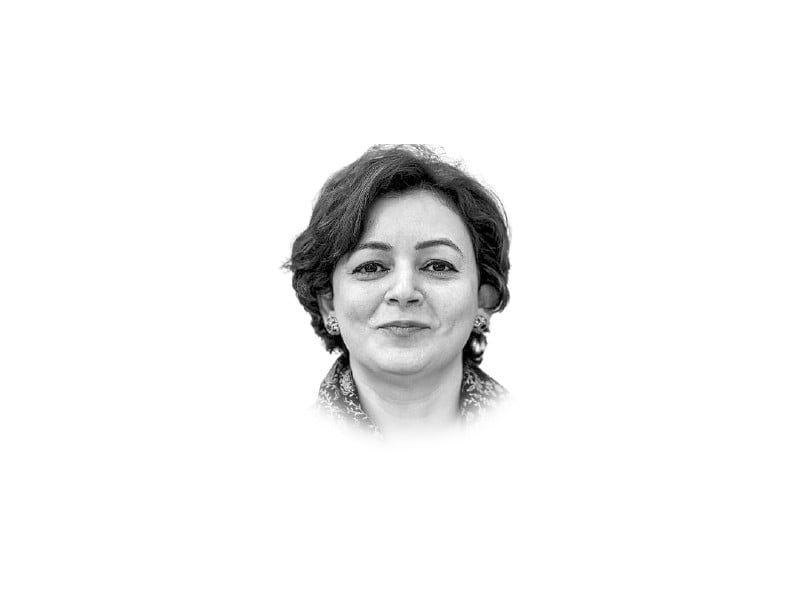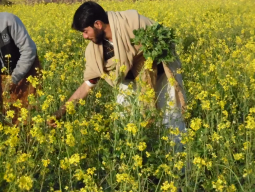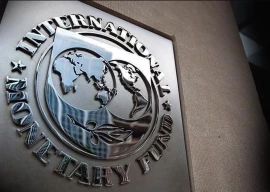
Dear Mrs Anna Molka Ahmed,
Sitting in the Principal's office, College of Art & Design Punjab University, one can't surpass your mercurial presence overarching other brilliant artists and educators, mostly your students, who have been carrying on your legacy since you left that seat. A life-size painting of you, wearing a scarlet red shirt and white dupatta, shalwar, dominates the room. This bold fashion statement, captured by Prof Khalid Iqbal, embodies the zeal and zest of "the first woman painter of Pakistan" and the confidence and commitment of "an educationist determined to change the course of art education in Pakistan".
Your life story is a testament to fate and fortune. Who would have thought that an 18-year-old girl from London would leave her family to move to India, embracing it as her home forever? They say that you were chasing the love of your life, Sheikh Ahmed Sb. How romantic! But then you chose to stay back even after parting ways with him and proved your devotion to art and the land. The universal principle and the ultimate agency were definitely on our side as they sent you to help locate the missing links between Indian art and the British education policy. When most of the British officials were busy establishing their cultural hegemony onto their Indian subjects ignoring Indigenous acumen of Reality and Existence and its quest through artistic endeavours, you created a haven for the art enthusiasts to pursue their dream of learning and practising art to absolve the mysteries of nature. You laid the foundations of art education in pre-partitioned Lahore and later firmly steered Pakistani art in its infancy elevating it to the pinnacle where it could bear the societal and other political pressures and thrived. The then Lahore had the privilege of having the Mayo School of Arts too; in fact more than half a century older than the Fine Arts department that you established for the Punjab University in 1940. The Mayo School had lost its real spirit somewhere between ideology and practice. Historians and critics of colonial India blame Britishers for orienting Mayo School towards industrial arts; craft-based metal and woodwork mainly to satisfy the needs of Indian pavilions in art expositions. It is also reported that post-partition Mayo School was serving best by producing dowry items for the bureaucrats' daughters. Even if it is true, I am sure it was not part of Macaulay's, Hawel's or Kipling's scheme. Our administrators are notorious for exploiting national resources to meet personal agendas.
However, such criticism and the tussle between arts and crafts negate the utilitarian value of art strongly advocated and practised in most Eastern societies. Even in Western cultures, before the 18th century most art was to serve some higher purpose other than just aesthetic experience and judgement of beauty. Art had served religion - the illuminated scriptures, the dangling heavenly light reflected through the stained-glass windows and frescoed ceilings all created warmth or awe in the hearts of the believers as they witnessed the marvels. India too, in pursuit of religious obligations sponsored by its never-ending resources and its ever-thriving economy that compelled the medieval travelers to call it a 'golden sparrow', had the privilege to indulge not only in exuberant architectural wonders but luxuriously designed everyday items. My point is there is no harm in approaching art as a craft. No art is devoid of skill, and mastery is to be acquired through constant practice and repetition. It's just a matter of varying trends and changing times that art is often categorised as craft or folk and kitsch. No wonder the 19th-century idea of 'art for art's sake' proved short-lived. Such debate needs more reflection for which I shall write to you again. For now, I congratulate you on prompting a smooth transition from traditional to modern art. You took your students on outdoor painting excursions, created life-size portraits in oil and explored figural compositions on subjects like Ashura processions instead of mindlessly imposing Western abstraction as the only choice for post-partition Pakistan. Your approach respected local traditions while embracing modernity, earning you respect and admiration in today's Pakistan. Warm regards, Bano.


















COMMENTS
Comments are moderated and generally will be posted if they are on-topic and not abusive.
For more information, please see our Comments FAQ